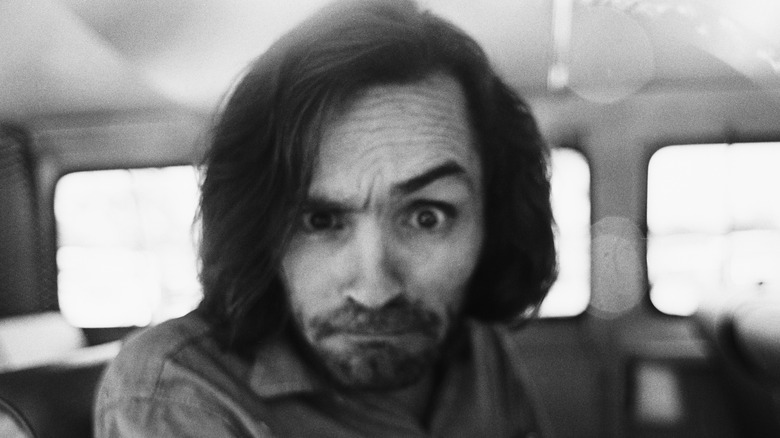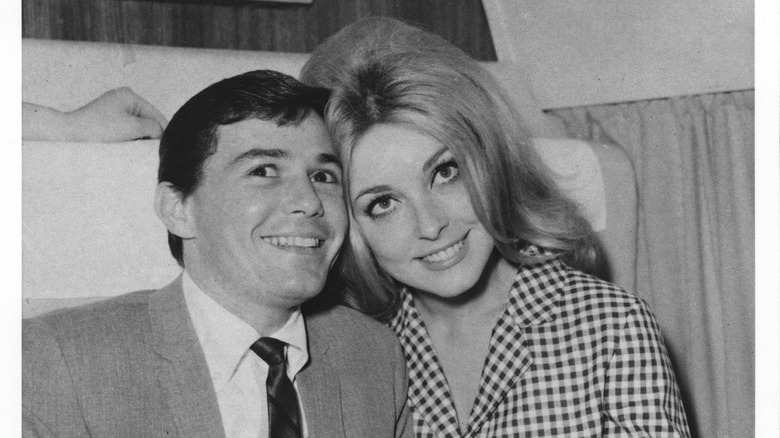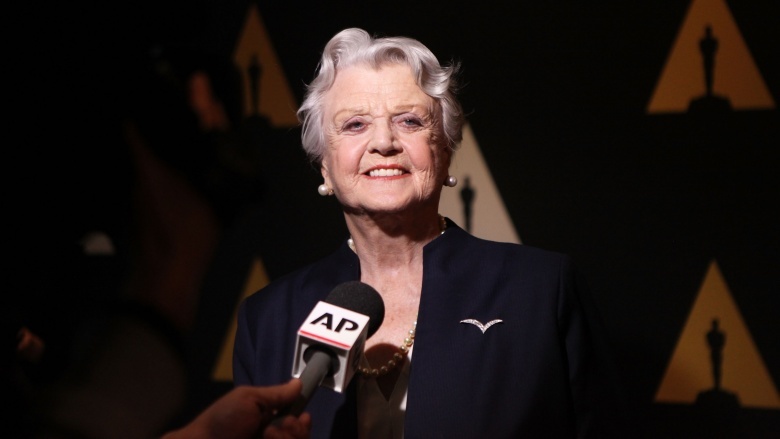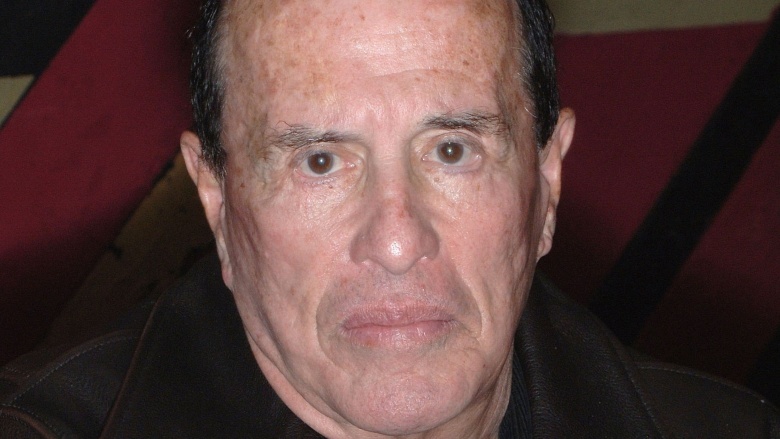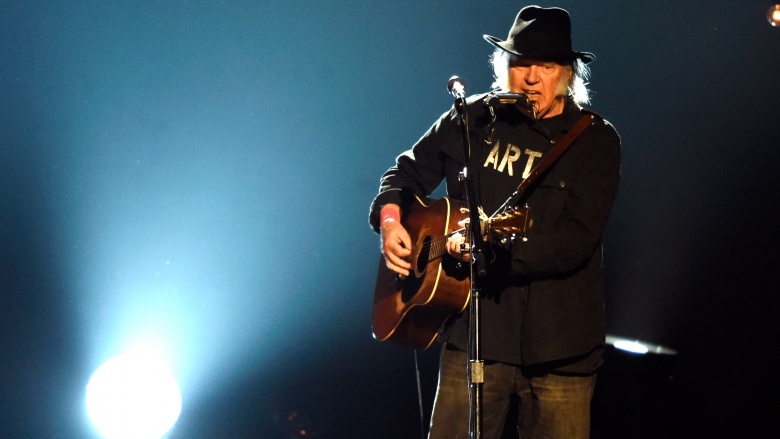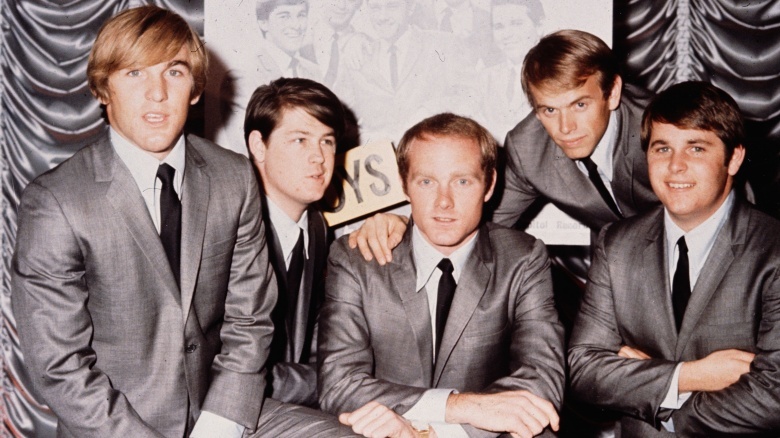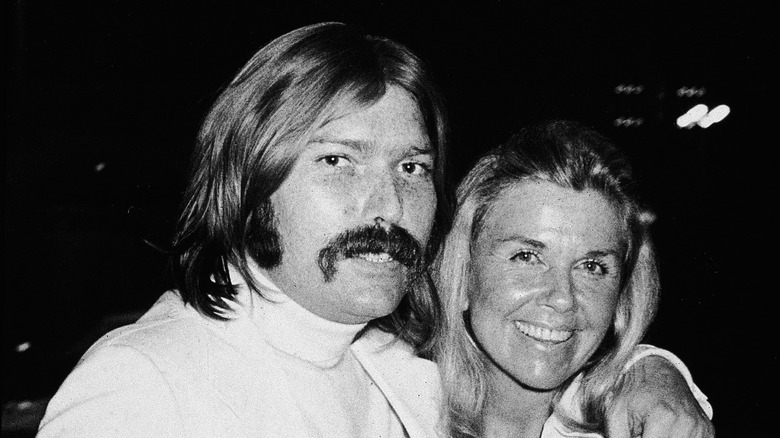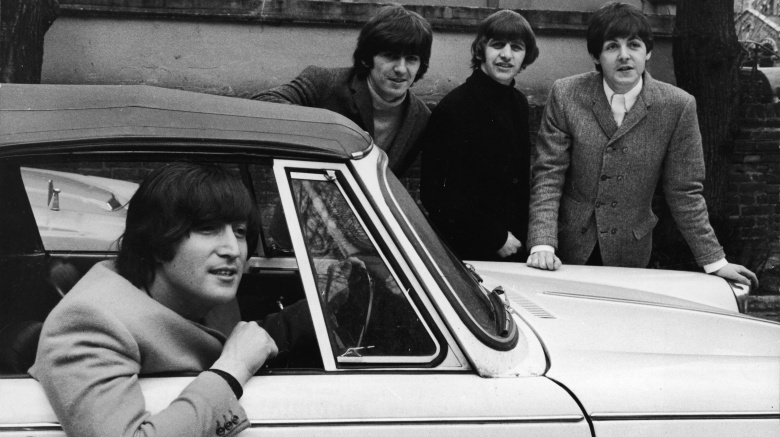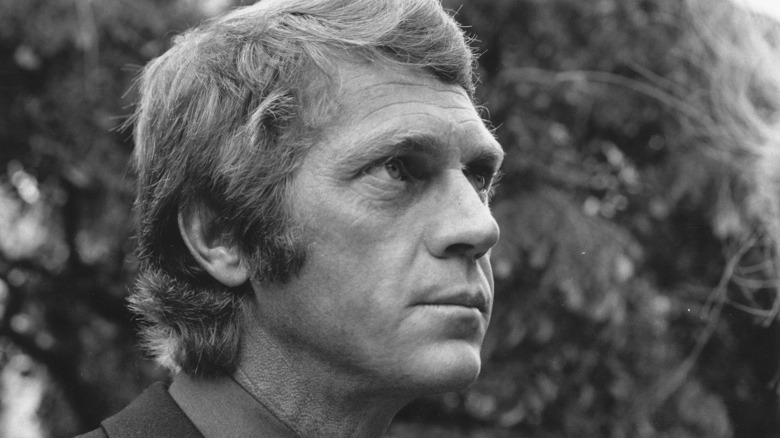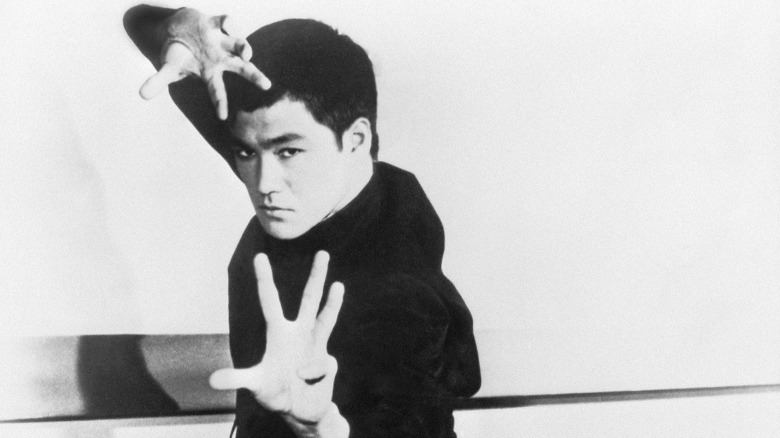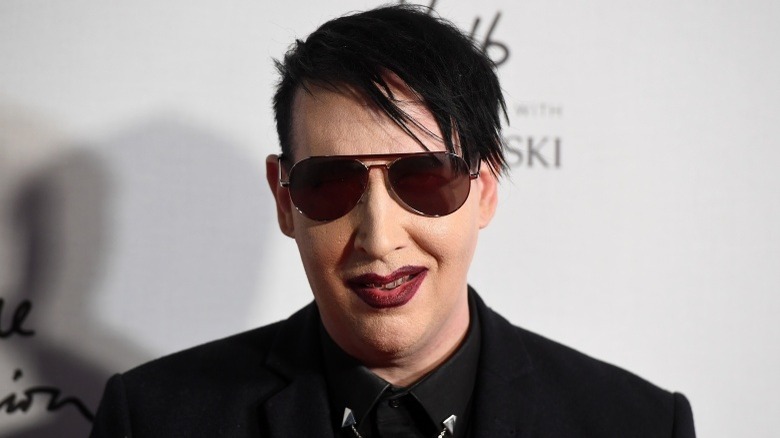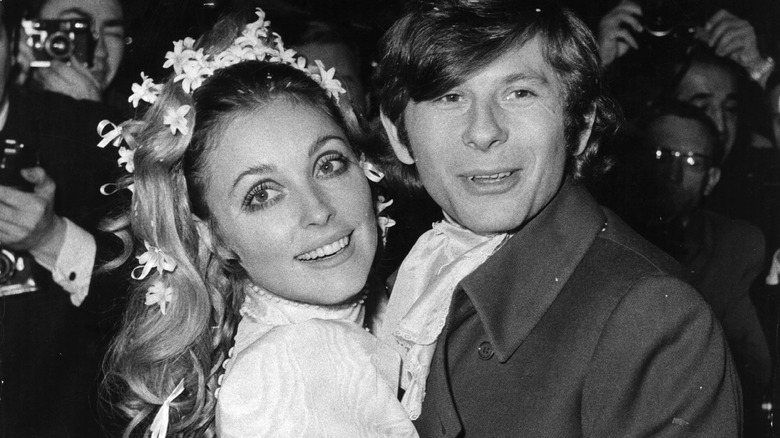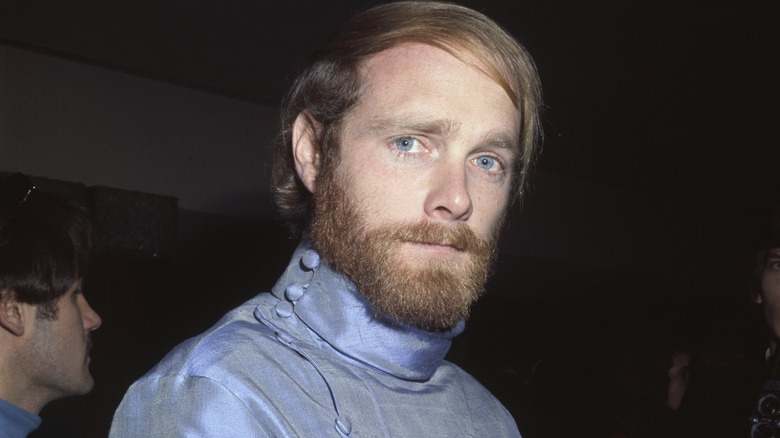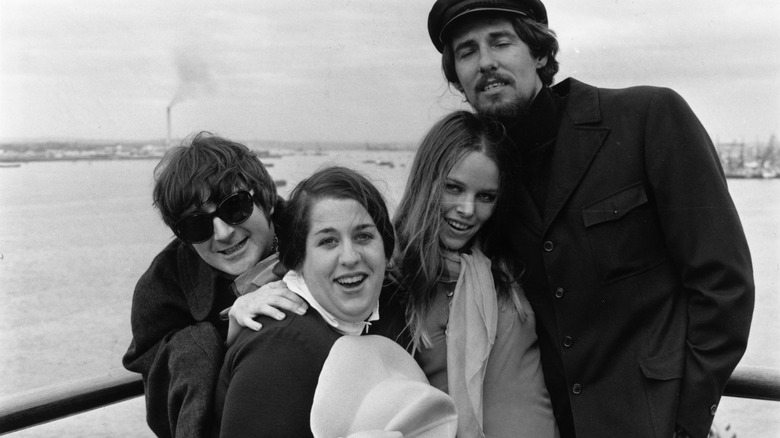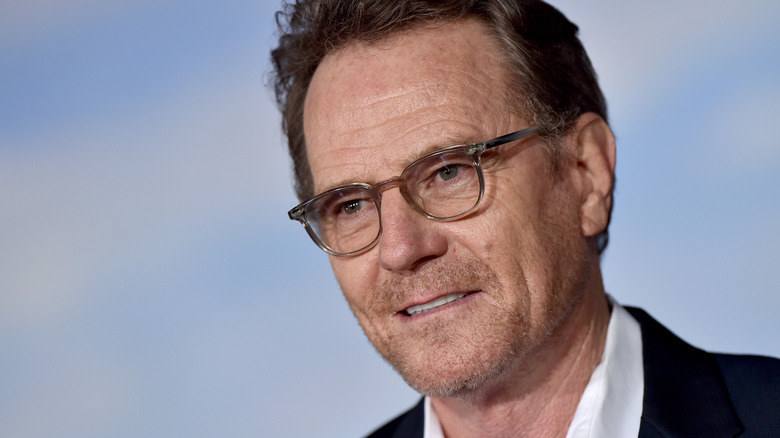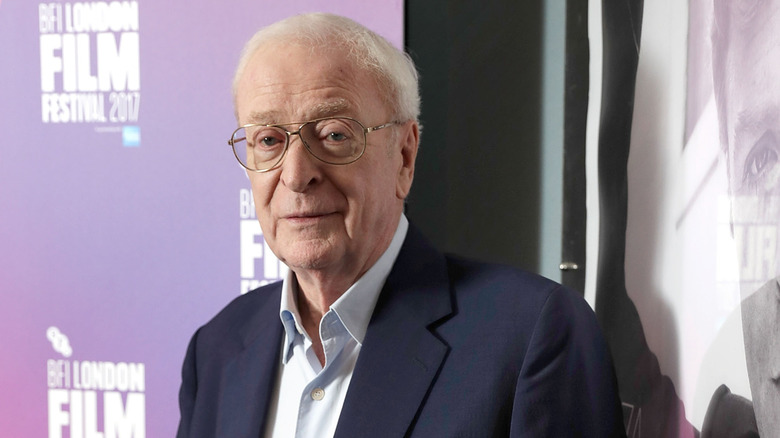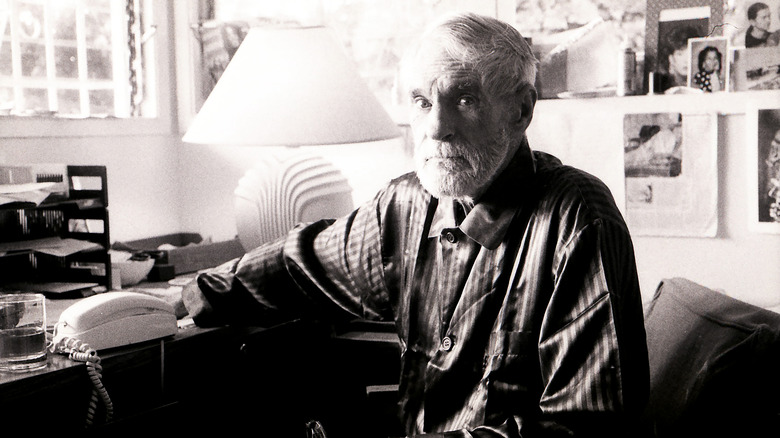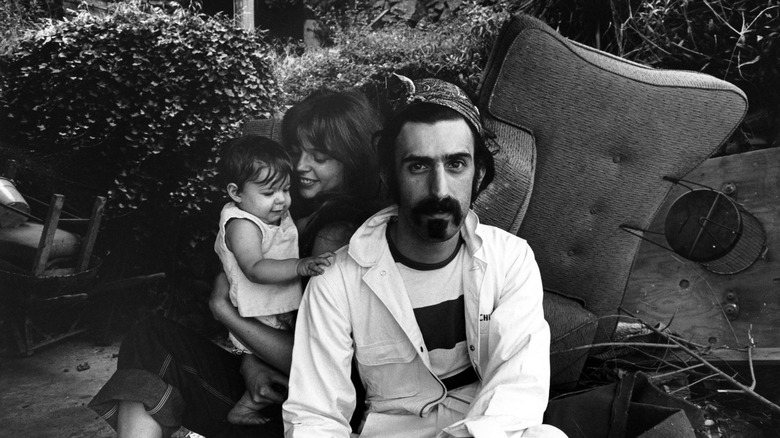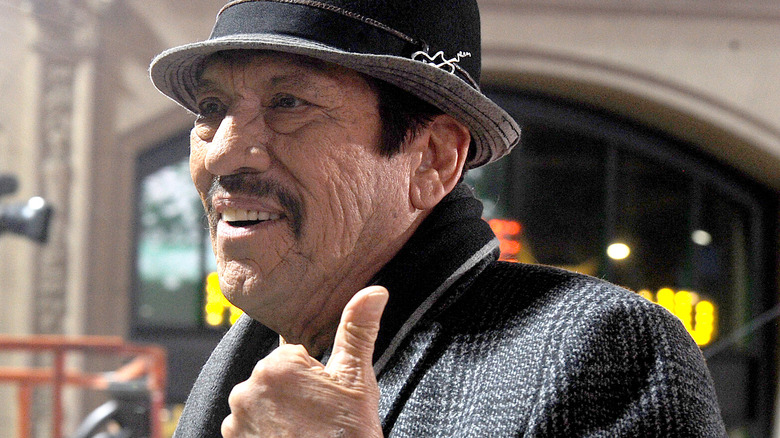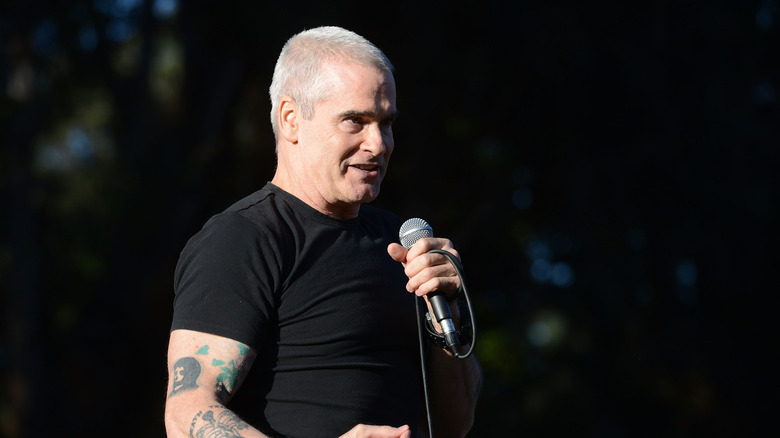Celebrities Connected To Charles Manson
In July and August of 1969, Charles Manson's cult made international headlines for murdering Sharon Tate, the star of films like "Valley of the Dolls," and wife of famed director Roman Polanski. But that wasn't the first time the Family had brushed up against celebrity. Charles Manson was possibly the best-connected killer in American history, with acquaintances across the acting and music industries. Even stars who didn't personally know the man felt the repercussions of his crimes, and those who had the misfortune of meeting this madman walked away shaken and terrified ... or they didn't walk away at all.
Jay Sebring
While Sharon Tate is the Manson Family's most famous victim, she wasn't the only one to die on August 9. When four psychos attacked her house on 10050 Cielo Drive, they also murdered Abigail Folger, Wojciech Frykowski, and Steven Parent. But after Tate, the most famous of the Cielo Drive victims was Jay Sebring, hairdresser to the stars.
After learning to cut hair in the Navy, Sebring set up shop in Los Angeles as a self-described "hair architect." The man was well-known for his hip-hugger jeans and chambray shirts, and his salon was decked out with a stained-glass window and an ankh cross. When guests came to get their hair done, they could knock back champagne while they were attended by beautiful women.
In addition to his snazzy style, Sebring was a pioneer. He was the first to give shampoos to men, and he popularized the use of handheld hairdryers in the US. Sebring charged an arm and a leg, but his clients could afford his price. After all, he serviced Rock Hudson and Henry Fonda. Kirk Douglas hired him to work on Spartacus and praised him as "a genius with hair." Sebring would fly out to Vegas to work on Frank Sinatra (and provide him with hair pieces), and he regularly took his clippers to Steve McQueen's house ... along with plenty of cocaine.
In his spare time, he raced cars with Paul Newman, and it's said Warren Beatty partially based his movie "Shampoo" on Sebring's life. The stylist also briefly dated Sharon Tate before she dumped him for Polanski. Nevertheless, the two remained friends, and he often visited the actress at her home. Tragically, he was there the night when Charles "Tex" Watson showed up, and Manson's lieutenant shot the hairdresser to death.
Angela Lansbury
Like any other cult leader, Charles Manson was all about power and sex. So when testing female members, Manson forced them to pass lengthy and involved sexual initiations. Of course, not every woman was willing to put up with Manson's proclivities, but that didn't mean they were automatically out of the group. If Manson couldn't win their undying obedience, he'd take their cash instead. The man was always on the prowl for easy marks — the richer, the better — and that's why he occasionally targeted the daughters of famous movie stars.
According to prosecutor Vincent Bugliosi, Manson once tried to woo Dean Martin's daughter, Deana. While that didn't pan out, Manson had more success with Deirdre "Didi" Lansbury, daughter of Angela Lansbury. Best known for shows like "Murder, She Wrote" and movies like "Beauty and the Beast," Lansbury didn't know what trouble her daughter was getting into. According to multiple sources, she actually gave Didi a note, proving the teenager had permission to hang out with these long-haired vagabonds.
Unlike most of Manson's women, Deirdre never moved out of her home. Instead, Manson picked her up after school, and they went on massive spending sprees, running wild with Angela Lansbury's credit cards. Of course, no good scam lasts forever, and eventually the cards were cut off. When the money well ran dry, Deirdre was out of the Family.
Fortunately for everyone, Angela Lansbury soon realized her kids were in trouble. In addition to the Manson connection, her son, Anthony, was struggling with drug abuse. Hoping a change of scenery might improve things, the Lansburys relocated to Ireland. Soon, Anthony was working on TV, and Deirdre opened a popular restaurant in California, a fine alternative to either rotting in jail for murder or being murdered.
Kenneth Anger
In the 1960s, Kenneth Anger was a key player in the underground film scene. A man obsessed with everything from black magic to sadomasochism, his biker film "Scorpio Rising" influenced Martin Scorsese, popularized the use of pop music in movies, and carved out the motorcycle movie genre. Plus his book, "Hollywood Babylon," was full of Hollywood gossip, dishing the goods on stars like Marilyn Monroe. True, most of his stories were fiction, but readers didn't care, and the book made Anger a big name among pop culture aficionados.
But while working on a film called "Lucifer Rising," Anger ran into an actor/wannabe musician named Bobby Beausoleil. Anger grew obsessed with the young man, casting him as the protagonist of his film and letting Beausoleil live in his mansion. The two sporadically worked on the movie, until they had a falling-out after Anger accused Beausoleil of stealing the film.
Homeless, Beausoleil eventually met up with Charles Manson. While he never joined the Family, the two enjoyed hanging out together, and Manson hoped Beausoleil's good looks would entice more women to join the cult. However, things went south when Manson asked his buddy to shake down a music teacher-turned-drug dealer named Gary Hinman. Along with two Manson women, Beausoleil took Hinman hostage for four days, beating him repeatedly. And after Manson slashed Hinman's ear with a samurai sword, Beausoleil stabbed the man to death.
It was the killing that started everything, but Beausoleil was arrested long before the rest of the Family. While in prison, Beausoleil made up with Kenneth Anger, even creating the soundtrack for the director's finished version of "Lucifer Rising."
Neil Young
More than anything else in the world, Charles Manson wanted to become a rock star. He truly believed it was his destiny, and he spent an inordinate amount of time trying to impress producers and singers. He personally performed for Mama Cass Elliot, and Bobby Beausoleil tried to sell some of Manson's songs to Frank Zappa. Jackson Browne even once considered visiting Manson's hangout, but fortunately he decided not to go.
Another singer Manson tried to win over was rocker Neil Young. The man behind songs like "Old Man, "Heart of Gold," and "Southern Man," Young is a master lyricist and musical genius. He was also friends with Beach Boy Dennis Wilson (more on him in a moment), and while visiting Wilson's house one day, he ran into the bearded cult leader himself. During their meeting, Manson took Young's guitar and began improvising a few songs. Young later said Manson's songs were "kind of like Dylan, but different because it was hard to glimpse a true message in them, but the songs were fascinating. He was quite good."
Impressed, Young promised to spread Manson's name around town and help the man get a recording contract. But unfortunately for nine random victims, Manson's musical career never panned out.
Dennis Wilson
The drummer for the Beach Boys, Dennis Wilson was a notorious womanizer, and that's probably why he picked up two female hitchhikers one day while driving to his Sunset Boulevard home. Those women were part of the Manson Family, and when they told their messiah they'd met a Beach Boy, Manson thought this was his chance to finally get a record deal.
Without invitation, the Family moved into Wilson's house, and the cult leader quickly impressed Wilson with his spiritual beliefs. (It helped that the drummer also liked fooling around with the Family women.) An excited Wilson tried to convince his fellow band members that Manson was the real deal, but they thought Manson was just a freak.
Unfortunately for Wilson, the Family took full advantage of their new benefactor. They used his clothes to make robes for Manson. They got ahold of Wilson's charge account and ran up a hefty bill, and the Beach Boy paid for their medical bills. In just a few months, the Manson Family had cost him over $100,000, and had wrecked one of his Ferraris.
Still, Wilson couldn't kick the Family out, partly because he was scared of Manson by this point. Terrified, Wilson simply moved out and let his lease expire, forcing the landlord to kick out the cult. However, Wilson got his revenge when he took one of Manson's songs, "Cease to Exist," rewrote it as "Never Learn Not to Love," and took sole credit as composer. Naturally, this didn't sit well with Manson, and the thug threatened Wilson's kid, even sending the drummer a bullet as a message.
Fortunately, the Family didn't follow up on their threats. "I'm the luckiest guy in the world," Wilson later said, "because I got off only losing my money." Still, Wilson usually refused to talk about his relationship with the Family. Tragically, the drummer also struggled with substance abuse, and on December 28, 1983, Dennis Wilson drowned in the ocean.
Doris Day and Terry Melcher
The star of films like "Calamity Jane" and "Pillow Talk," Doris Day won the hearts of audiences as the "girl next door." And as she was singing on-screen, her son was making a name in the music industry. Terry Melcher was a producer at Columbia Records, and helped produce hits like "Mr. Tambourine Man," by The Byrds. Melcher also ran with a hip crowd, dating model Candice Bergen and hanging out with Dennis Wilson.
It was thanks to Wilson that Melcher met Charles Manson. The producer and cultist often partied together, and Melcher enjoyed spending time with Manson's female followers. Manson believed Melcher could make him a star, and he gave the producer tapes to listen to. He even invited Melcher to his hangout, Spahn Ranch, for a special concert. However, Melcher never listened to the tapes and even stood Manson up, neglecting to attend the cult leader's performance. Melcher was busy trying to save his mother from bankruptcy and didn't have time for a bunch of hippies, which made Manson incredibly impatient. When he finally did visit the ranch to hear Manson perform, he politely told the cult leader it was time to put down the guitar.
Feeling betrayed by Melcher, Manson shifted his attention from singing to preparing for a self-prophesied race war. When the killings started, the Family attacked Terry Melcher's house at 10050 Cielo Drive, simply because they knew where it was. However, Melcher had moved out by then, and the new tenants were Roman Polanski and Sharon Tate.
After Manson was arrested, Melcher was understandably terrified. He hired bodyguards, bought guns, and had to take a tranquilizer before testifying against the cult leader. Fortunately, Melcher never ended up on Manson's hit list. Instead, he helped revive his mom's career and co-wrote the Beach Boys super-hit song "Kokomo," before passing away in 2004.
The Beatles
If you know anything about Charles Manson, you know he was obsessed with The Beatles. He first heard their music while serving time for forgery, but as the years went by, his relationship with the band took a dark turn. By the time he was a cult leader, Manson claimed The Beatles were sending him secret messages in their songs. In fact, he felt their release, "The White Album," was one big prophecy meant especially for the Family.
According to Manson, The Beatles were predicting an apocalyptic revolution called "Helter Skelter." During this uprising, black people would slaughter all the white people, except for the Manson Family, who would enslave the black people and rule the world.) For proof, Manson pointed to the songs "Blackbird" and "Happiness is a Warm Gun." Manson also cited "Revolution 9" as evidence, claiming the song was connected to the Book of Revelations, chapter 9. He's the only person to ever hear "Revolution 9" as anything but pure gobbledygook.
Manson also claimed The Beatles needed his help to survive the apocalypse, and their song "Honey Pie" was a plea for the cult to travel to England. He also claimed The Beatles wanted him to write a response album, thus justifying his desire to become a rocker. As further proof of his crazy claims, he explained how the song "Sexy Sadie" was named after Manson follower Susan Atkins, a woman he'd coincidentally nicknamed "Sadie."
When the Manson Family finally carried out the killings, they used the blood of their victims to write words from Beatles songs on the walls, including "Healter [sic] Skelter." And after their arrests, Manson's followers were genuinely confused why The Beatles weren't coming to their defense. As for the Fab Four, when asked what they thought about Manson, John Lennon said the man was absolutely "barmy," which is Lennon-speak for "completely wall-bouncing bonkers."
Steve McQueen and the death list
After the Tate/LaBianca murders, everyone in Hollywood freaked out. Mia Farrow refused to attend Sharon Tate's funeral because she worried she might end up dead. Jerry Lewis installed a state-of-the-art alarm system in his home, hoping to prevent anyone from creeping into his house. But the guy who panicked the most was the King of Cool himself, Steve McQueen. And truthfully, he had a legitimate reason.
It took a shockingly long time for the police to solve the Manson killings, and it wasn't until Family member Susan Atkins was arrested on unrelated charges that detectives broke the case. While behind bars, Atkins admitted the killings to several inmates, and she also made a particularly crazy claim. According to Atkins, the Family had created a celebrity "death list," and they were planning on killing Elizabeth Taylor, Richard Burton, Tom Jones, Frank Sinatra, and, of course, Steve McQueen.
When word of the list leaked out, McQueen carried a pistol on his person at all times. Of course, it should be noted that Atkins was mentally disturbed, and the death list could possibly be a fabrication. After all, according one L.A. prosecutor, Atkins was "the scariest of the Manson girls," and she was the one who actually murdered a pregnant Sharon Tate.
Some people also claim McQueen was invited to Sharon Tate's house on the night of the killings, but that story seems rather unlikely as well, considering the same thing has been said about everyone from Peter Sellers to Kirk Douglas to Bruce Lee. Speaking of the kung fu master...
Bruce Lee
Before her murder, Sharon Tate appeared in a Dean Martin movie called "The Wrecking Crew," a spy comedy featuring lots of martial arts. Since Martin and Tate weren't skilled at fighting, the legendary Bruce Lee was brought on board to teach the actors how to look cool while throwing kicks. While Lee thought Martin was "too lazy and too clumsy," he was impressed with Tate's ability at throwing sidekicks "with just a minimum of teaching."
Soon, Roman Polanski hired the actor for private lessons. On a couple of occasions, he flew Lee out to Switzerland, and other times, they trained on Patty Duke's driveway. Interestingly, Lee was also connected to Jay Sebring, as the hairstylist introduced the martial artist to the producer of the "Batman" TV show. As a result, the producer cast Lee as the superhero Kato in "The Green Hornet."
However, after the killings, Polanski became incredibly paranoid, suspecting his friends were involved in the murders. He actually bugged houses and checked friends' cars for blood stains. But things took a twist when police officers found a pair of glasses at the crime scene. Suspicious, Polanski began checking all his friends' prescriptions, and the director soon suspected Lee of the killings, when the martial artist admitted he couldn't find his glasses anywhere.
Wondering if his instructor murdered his wife, Polanski took Lee to see an eye doctor and bought him a new pair of glasses, just to see what kind he wore. Little did Polanski know, those eyeglasses from the crime scene actually came from Manson himself. The tricky mastermind had visited the Cielo Drive house after the murders and dropped little "clues," like the glasses, to throw off the cops.
Marilyn Manson
Whether or not you're a Marilyn Manson fan, you probably know that's not his real name. The rocker was born Brian Hugh Warner, but he adopted his stage moniker in honor of Marilyn Monroe and Charles Manson, who he claimed were, "the two biggest icons of the 1960s." (Monroe was most famous in the '50s and died in 1962, but whatever.) The singer took his Manson obsession even further when he covered one of the cult leader's songs, "Sick City," in 2000.
Evidently, killer Manson was impressed with rocker Manson as well, because he sent the singer a wildly incoherent letter, which referenced everything from the devil to his environmental non-profit, Air, Trees, Water, Animals (ATWA). For your reading pleasure, here's the letter in its entirety. Good luck making any sense of it.
To Marilyn Manson —
It's taken me a long time to get there from where I could touch M. Manson. Now I got a card to play—you may look into my non-profit, ATWA, and give Manson what you think he's got coming for Air, Trees, Water, and you. Or I will pay Manson what you think Manson got coming—the music has make Manson into Abraxas Devil, and I'm SURE you would want some of what I got from what I got. It's a far out balance. Beyond good and bad, right, wrong. What you don't do is what I will do—what you did a sing-along, and let it roll and said how you saved me a lot of steps—I don't need, it's not a need or a want. Coupled—coup. Ghost dancers slay together, and you're just in my grave Sunstroker Corona-coronas-coronae—you see me from under with it all standing on me. That's 2 dump trucks—doing the same as CMF 000007.
Charles Manson
Sharon Tate and Roman Polanski
Sharon Tate has the most tragic connection to Charles Manson, for infamous reasons. Although her husband, the director Roman Polanski, wasn't at their home on Aug. 9, 1969, she was — along with friends Abigail Folger, Wojciech Frykowski, Steven Parent, and Jay Sebring. That is, of course, when members of the so-called Manson family stormed the house and committed the brutal murders that culminated in deaths that included Tate's unborn baby.
Although the most common narrative is that Manson chose the house to carry out high-profile killings designed to start a race war (which he would eventually lead the winners of), Vox says that it was a little more complicated than that. In the months leading up to the murders, Manson was involved in killings of a more hands-on kind. In May, he had shot and killed a drug dealer named Bernard Crowe, and shortly afterward, he had urged some of his family members to hit up a friend of his for some quick cash. Several days of torture ended with the death of Gary Hinman, a murder that family member Bobby Beausoleil was arrested for three days before Tate was killed.
Manson dispatched his followers to the house (which History says was chosen because it was the former home of a record producer who had refused to sign Manson), with orders to kill — and ultimately, to make it look like the same person who had killed Hinman had committed these murders, which Manson hoped would lead to Beausoleil's release. It did not.
Mike Love
Dennis Wilson might be The Beach Boys' most famous connection to Charles Manson, but he isn't the only one: Mike Love had some run-ins with Manson as well. Love spoke with ABC News in 2017, calling their connection with Manson "the worst thing that could possibly happen" ... and it gets stranger.
This was, Love stressed, when the Manson family was more about free love and less about murder. Wilson (who is Love's cousin) became obsessed with Manson and his harem of devoted followers, but Love was less impressed. Wanting to get the rest of the group to join the Family, Manson invited them to Wilson's house (where they were all living at the time). Love recalled that he was one of two people wearing clothes, and when Manson invited him to partake in a post-dinner acid trip, he declined. When Love went to leave, he recalled, "He said, 'You can't do that.' I said, 'Excuse me?' He said, 'You can't leave the group.' It was a pretty intense look."
Love got out of the house, and was shaken by the ordeal. Still, it gets weirder. His then-wife Suzanne was having an affair with Wilson, and Love wrote in his memoirs (via People) that after he split with his wife, she'd often go out and leave the kids with a babysitter. And that? It was Susan Atkins, who witnesses later identified as the one who wrote "PIG" on the door in Sharon Tate's blood."
Cass Elliot and John Phillips
The story of The Mamas and the Papas is so tawdry, over-the-top, and downright shudder-inducing that it borders on the ridiculous, and it includes a bizarre connection with Charles Manson. It starts, says the Chicago Tribune, with the wanna-be musician Manson attending all kinds of free-love parties, and getting his groove on alongside both "Mama" Cass Elliot (center left) and John Phillips (right). Does it get stranger? Of course it does.
In his memoir, "Papa John," Phillips spends a good amount of time talking about his friendship with Roman Polanski and Sharon Tate. (And anyone who thinks they can see where this is going? They definitely cannot.) Phillips wrote that when the news of the murders broke, everyone was worried about him — because he was often at the Tate/Polanski house, he had to reassure everyone he was fine. Weeks passed, and Phillips wrote that Polanski started his own investigation ... into him. Polanski, Phillips wrote, was convinced that he had something to do with the slaughter that had taken place at 100500 Cielo Drive, and allegedly went as far as breaking into Phillips' home with a police test kit to look for evidence. What did Polanski think was the motive? Retribution for Polanski's fling with Michelle Phillips (center right).
Things came to a head one night when Polanski allegedly grabbed Phillips, held a cleaver to his throat, and demanded to know if he'd been behind the murders. He assured him that he had not, and once Manson's trial started, "life was more or less back to normal."
Bryan Cranston
Here's a story that proves no one can ever be entirely sure just who they're going to cross paths with. At one time, the Spahn Ranch was a highly sought-after shooting location for movies and television shows that included big names like "Bonanza." According to History, ranch owner George Spahn allowed the Manson Family to move in, in exchange for having work done around the property. They had come across the ranch sometime in 1967, and according to what Bryan Cranston revealed on "The Dan Patrick Show," that was about the same time he and his cousin would go horseback riding through the property.
The then-12-year-old Cranston was just getting ready to set out when, he recalled, someone came in and started screaming, "Charlie's on the hill!" A group of others jumped on their horses and took off ... but meanwhile, the stable owner told Cranston and his cousin to not mind that at all, here's your horses, have a great ride.
Only about 20 minutes into the ride, they passed a group of horses and riders, single file. "And in the middle of this pack, there was this one little man with black hair, and dark, dead eyes," Cranston recalled. "... he was just out of his mind," he said, describing a figure who looked like he was ready to fall off his horse at any second. Cranston said they didn't think anything more of it ... until they saw the news of the Manson family murders a year later.
Michael Caine
While Michael Caine might seem as far away from the Manson Family's semi-transient lifestyle of hedonistic pleasures at the Spahn Ranch as it's possible to get, Caine did have a run-in with him.
According to The New York Times, Caine recalled the incident in his memoir, "What's It All About?" Caine, apparently, was less enamored of the man than many people who met him, saying that he was a "scruffy little man" who also happened to be at one of the many, many parties thrown by Cass Elliot of the Mamas and the Papas. While it's not clear just how long people spent talking to each other, he did also add that both Sharon Tate and hairstylist Jay Sebring — the Manson Family's ill-fated victims — were also at the party.
Later in his memoir, Caine recalled moving to Los Angeles in 1979, describing himself as "a refugee from my own beloved country and living in a strange land." It was going to get stranger: While he was comforted by the fact that his new home was in the jurisdiction of Beverly Hills's emergency services, it was somewhat short-lived when he learned that he was living a few hundred yards from the house where Manson's followers had brutally murdered Tate and her friends.
Timothy Leary
No discussion about the counterculture of the 1960s is complete without a mention of Timothy Leary, and Charles Manson apparently believed that as well. Manson reporter and author Tom O'Neill says (via The Telegraph) that 1967 was a sort of formative year for Manson, as it's the year that he started exercising control over the women who would form his cult, and it was also when he started experimenting with acid. He was living in Haight-Ashbury at the time and was a regular visitor at an LSD clinic set up by CIA and MKUltra alum Dr. Louis Jolygon West.
This was the same year that LSD guru Timothy Leary did a stint in jail for possession and transport of marijuana, and when he was arrested again on the same charges just a few years later in California, that's when he was handed a 10-year sentence. According to the Pennsylvania Center for the Book, Leary was shuffled around a bit, and his multiple stays included one at Folsom Prison. In a bizarre, "truth-is-stranger-than-fiction" sort of moment, his next-door cellmate? It was, of course, Charles Manson, who reportedly went out of his way to tell Leary just how much he loved his work.
Frank and Gail Zappa
Certain areas have a certain reputation, and Joni Mitchell was once quoted as explaining the purchase of her Lookout Mountain home as coming after it was recommended to her as "where the craziest people live." In the 1960s, the Laurel Canyon area was known as a hotbed of inspiration and artistry that would change music forever, thanks to the likes of Mitchell, Cass Elliot, Jim Morrison, and scores of others — including Frank Zappa.
Grazia recalls Frank Zappa's Laurel Canyon house (where the above photo was taken) as always being open and inviting, where anyone and everyone was welcome. It was magical, but unfortunately, it's also human nature to take anything that's magical and crush it into little tiny pieces. Parties, drugs, and lifestyles got more extreme, and when the Manson Family murders went down, things were suddenly not-so-fun.
According to the documentary "Zappa," (via Newport This Week), the wildly welcoming home of Frank and Gail Zappa ended up closing the doors before the murders even happened. It was Gail who recounted the fact that after run-ins with their nearby neighbors — who she described as "creepy" — the Zappas decided to sell their house and move out of the area entirely. The creepy neighbors? The Manson Family.
Danny Trejo
Danny Trejo is one of those people who have packed a lot of living into a single life, and the release of his autobiography, "Trejo: My Life of Crime, Redemption, and Hollywood," promised to share a ton of wild stories. He spoke to Fox News about one incident in particular, and that was the time he spent in jail with Charles Manson.
This, Trejo clarified, was long before those infamous murders. He described Manson, writing, "He was so poor, he didn't have a belt, and instead used a piece of string to keep his pants up." He later clarified more, saying, "He was like a five-foot, slick little wimp. He wasn't a bully. Wasn't a thug. But he had the jargon of prison and jail. He thought he was slick."
Manson might have gotten a reputation as a charismatic cult leader outside of jail, but he wasn't that when he was inside of it — and Trejo said that he had even approached him (and his cellmates) looking for protection. But there was something chilling that he shared, and that was his belief that Manson could have been a professional hypnotist. He sat down with Trejo and walked him through the process of shooting up with heroin. Trejo said, "Even before I fake-fixed, I could taste it in my mouth. Any junkie knows what that is like. By the time he described it hitting my bloodstream, I felt the warmth flowing through my body."
Henry Rollins
In a 2008 interview with NME, Black Flag's Henry Rollins revealed something pretty shocking: Charles Manson had seen him on MTV and liked his work so much that the two became pen pals for a time. "We corresponded a few times in 1984; I'd just tell him about what we were doing with our new record and he'd send back semi-lucid responses," Rollins recalled, adding, "His letters would always have swastikas on them, so they were easy to spot."
It turns out, that wasn't the end of their contact. In 2010, Rollins appeared at an event for a Los Angeles radio station called KCRW, where he played little-heard recordings of artists from Debbie Harry and Queen to Iggy Pop and ... Charles Manson (via The Hollywood Reporter). Rollins said that he had been struggling when he was approached by SST Records on Manson's behalf, asking him to produce an album for him. Manson did all the recording from prison, and the record — called "Completion" — was actually finished when the project was squashed. Rollins said that the company had started receiving death threats when news of the record leaked, and of the five copies that were made, Rollins kept two of them.
